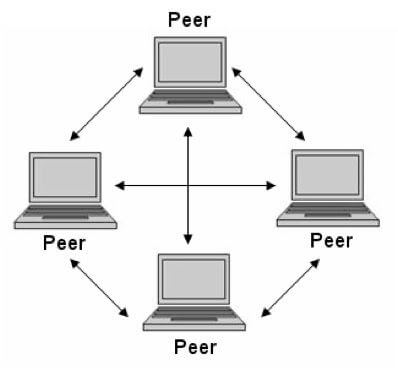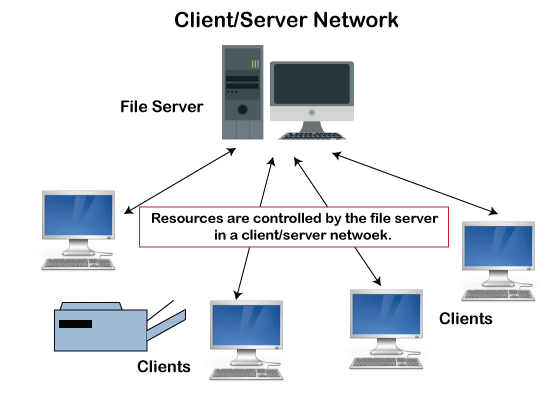History of the Operating SystemOperating SystemThe operating system is a system program that serves as an interface between the computing system and the end-user. Operating systems create an environment where the user can run any programs or communicate with software or applications in a comfortable and well-organized way. Furthermore, an operating is a software program that manages and controls the execution of application programs, software resources and computer hardware. It also helps manage the software/hardware resource, such as file management, memory management, input/ output and many peripheral devices like a disk drive, printers, etc. These are the popular operating system: Linux OS, Windows OS, Mac OS, VMS, OS/400 etc. 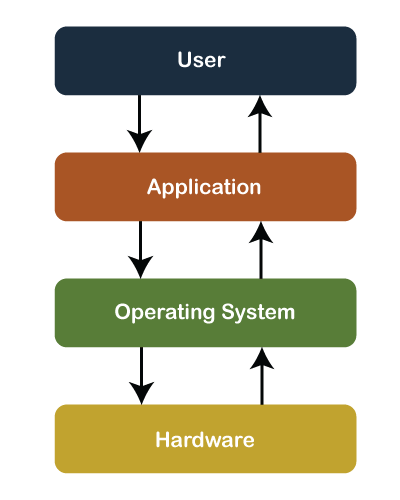
Functions of Operating System
Types of Operating System
Batch Operating SystemIn Batch Operating System, there is no direct interaction between user and computer. Therefore, the user needs to prepare jobs and save offline mode to punch card or paper tape or magnetic tape. After creating the jobs, hand it over to the computer operator; then the operator sort or creates the similar types of batches like B2, B3, and B4. Now, the computer operator submits batches into the CPU to execute the jobs one by one. After that, CPUs start executing jobs, and when all jobs are finished, the computer operator provides the output to the user. Time-Sharing Operating SystemIt is the type of operating system that allows us to connect many people located at different locations to share and use a specific system at a single time. The time-sharing operating system is the logical extension of the multiprogramming through which users can run multiple tasks concurrently. Furthermore, it provides each user his terminal for input or output that impacts the program or processor currently running on the system. It represents the CPU's time is shared between many user processes. Or, the processor's time that is shared between multiple users simultaneously termed as time-sharing. 
Embedded Operating SystemThe Embedded operating system is the specific purpose operating system used in the computer system's embedded hardware configuration. These operating systems are designed to work on dedicated devices like automated teller machines (ATMs), airplane systems, digital home assistants, and the internet of things (IoT) devices. 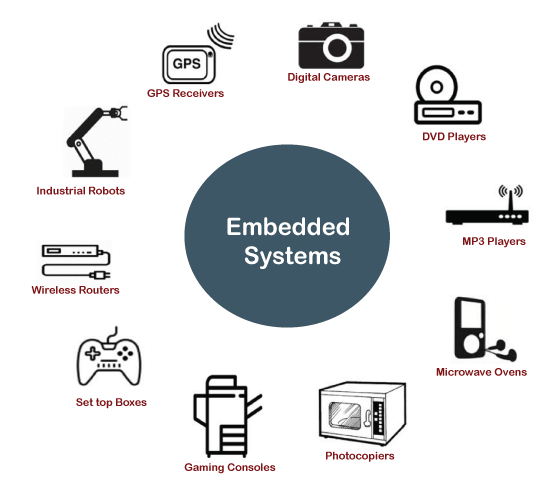
Multiprogramming Operating SystemDue to the CPU's underutilization and the waiting for I/O resource till that CPU remains idle. It shows the improper use of system resources. Hence, the operating system introduces a new concept that is known as multiprogramming. A multiprogramming operating system refers to the concepts wherein two or more processes or programs activate simultaneously to execute the processes one after another by the same computer system. When a program is in run mode and uses CPU, another program or file uses I/O resources at the same time or waiting for another system resources to become available. It improves the use of system resources, thereby increasing system throughput. Such a system is known as a multiprogramming operating system. 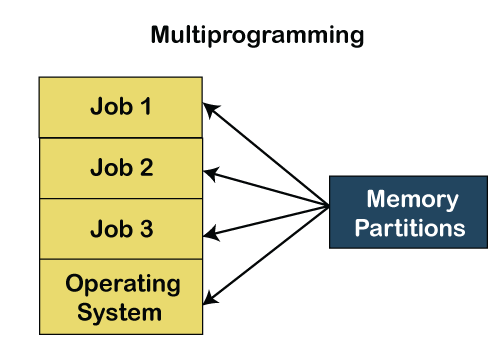
Network Operating SystemA network operating system is an important category of the operating system that operates on a server using network devices like a switch, router, or firewall to handle data, applications and other network resources. It provides connectivity among the autonomous operating system, called as a network operating system. The network operating system is also useful to share data, files, hardware devices and printer resources among multiple computers to communicate with each other. 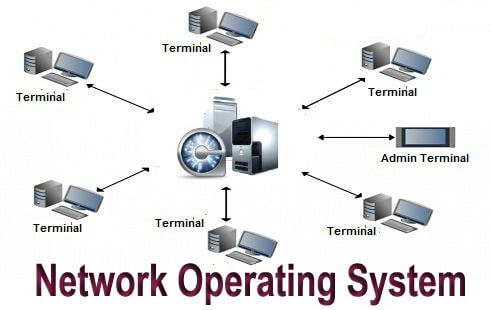
Types of network operating system
Distributed Operating systemA distributed operating system provides an environment in which multiple independent CPU or processor communicates with each other through physically separate computational nodes. Each node contains specific software that communicates with the global aggregate operating system. With the ease of a distributed system, the programmer or developer can easily access any operating system and resource to execute the computational tasks and achieve a common goal. It is the extension of a network operating system that facilitates a high degree of connectivity to communicate with other users over the network. 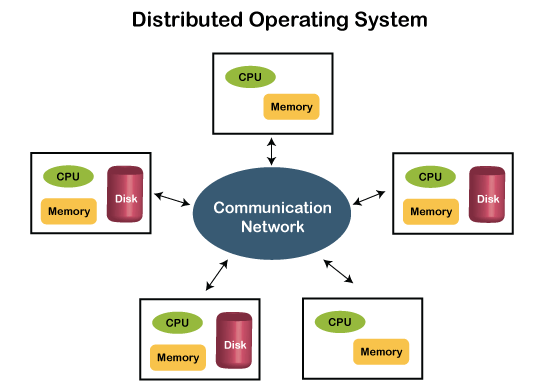
Multiprocessing Operating SystemIt is the type of operating system that refers to using two or more central processing units (CPU) in a single computer system. However, these multiprocessor systems or parallel operating systems are used to increase the computer system's efficiency. With the use of a multiprocessor system, they share computer bus, clock, memory and input or output device for concurrent execution of process or program and resource management in the CPU. Real-Time Operating SystemA real-time operating system is an important type of operating system used to provide services and data processing resources for applications in which the time interval required to process & respond to input/output should be so small without any delay real-time system. For example, real-life situations governing an automatic car, traffic signal, nuclear reactor or an aircraft require an immediate response to complete tasks within a specified time delay. Hence, a real-time operating system must be fast and responsive for an embedded system, weapon system, robots, scientific research & experiments and various real-time objects. Types of the real-time operating system:
Generations of Operating SystemThe First Generation (1940 to early 1950s) When the first electronic computer was developed in 1940, it was created without any operating system. In early times, users have full access to the computer machine and write a program for each task in absolute machine language. The programmer can perform and solve only simple mathematical calculations during the computer generation, and this calculation does not require an operating system. The Second Generation (1955 - 1965) The first operating system (OS) was created in the early 1950s and was known as GMOS. General Motors has developed OS for the IBM computer. The second-generation operating system was based on a single stream batch processing system because it collects all similar jobs in groups or batches and then submits the jobs to the operating system using a punch card to complete all jobs in a machine. At each completion of jobs (either normally or abnormally), control transfer to the operating system that is cleaned after completing one job and then continues to read and initiates the next job in a punch card. After that, new machines were called mainframes, which were very big and used by professional operators. The Third Generation (1965 - 1980) During the late 1960s, operating system designers were very capable of developing a new operating system that could simultaneously perform multiple tasks in a single computer program called multiprogramming. The introduction of multiprogramming plays a very important role in developing operating systems that allow a CPU to be busy every time by performing different tasks on a computer at the same time. During the third generation, there was a new development of minicomputer's phenomenal growth starting in 1961 with the DEC PDP-1. These PDP's leads to the creation of personal computers in the fourth generation. The Fourth Generation (1980 - Present Day) The fourth generation of operating systems is related to the development of the personal computer. However, the personal computer is very similar to the minicomputers that were developed in the third generation. The cost of a personal computer was very high at that time; there were small fractions of minicomputers costs. A major factor related to creating personal computers was the birth of Microsoft and the Windows operating system. Microsoft created the first window operating system in 1975. After introducing the Microsoft Windows OS, Bill Gates and Paul Allen had the vision to take personal computers to the next level. Therefore, they introduced the MS-DOS in 1981; however, it was very difficult for the person to understand its cryptic commands. Today, Windows has become the most popular and most commonly used operating system technology. And then, Windows released various operating systems such as Windows 95, Windows 98, Windows XP and the latest operating system, Windows 7. Currently, most Windows users use the Windows 10 operating system. Besides the Windows operating system, Apple is another popular operating system built in the 1980s, and this operating system was developed by Steve Jobs, a co-founder of Apple. They named the operating system Macintosh OS or Mac OS. Advantages of Operating System
Disadvantage of the Operating System
Next TopicTypes of OS
|
 For Videos Join Our Youtube Channel: Join Now
For Videos Join Our Youtube Channel: Join Now
Feedback
- Send your Feedback to [email protected]
Help Others, Please Share





